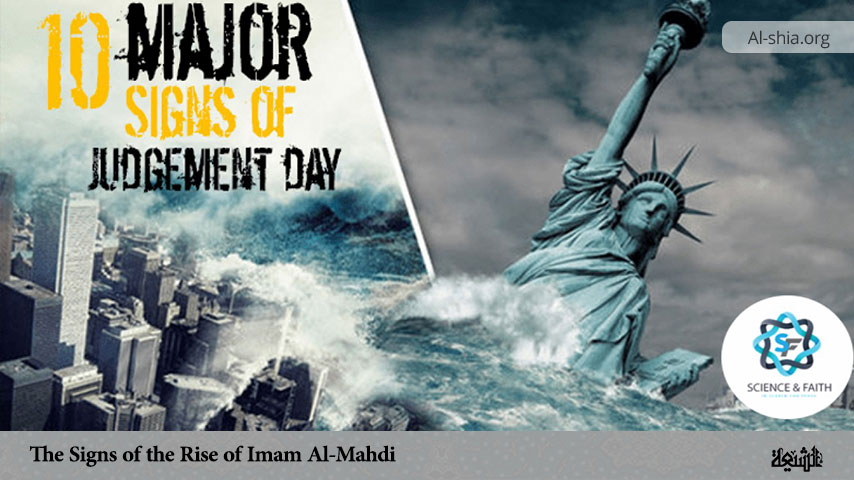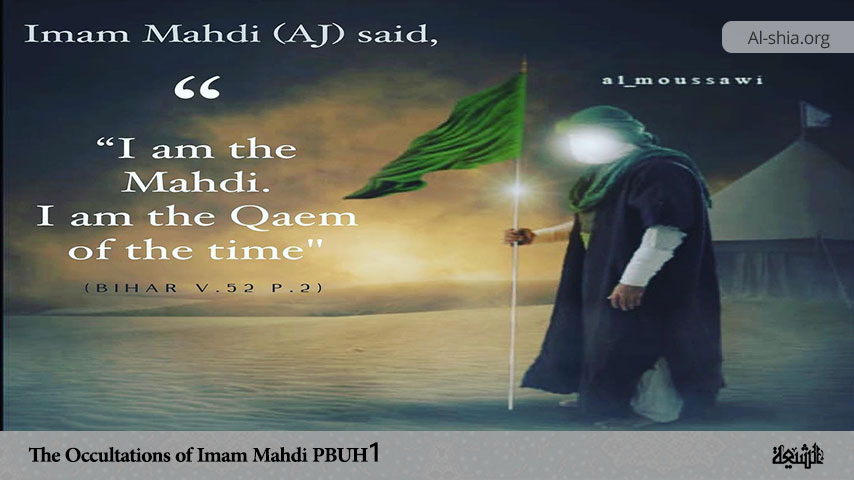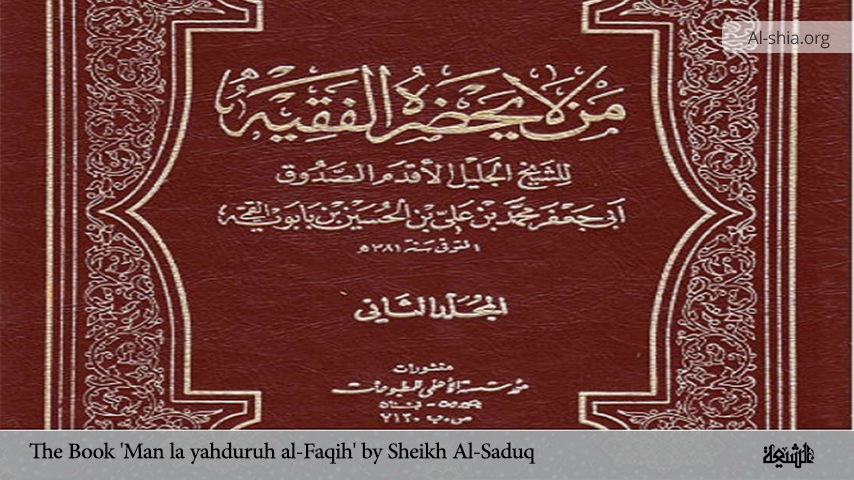The early Imamite traditionists delineated five signs which would precede the rise of al-Qaim al-Mahdi: first, the rise of al-Yamani, then the rise of al-Sufyani, thirdly the assassination of the Pure Soul (al-Nafs al-Zakiyya) in Mecca only fifteen days before the rise of al-Qa’im (al-Mahdi), fourthly an outcry in the morning from the sky in the name of al-Qaim, and finally the sinking of an army into the earth (al-Bayda) during its march on Mecca. (1) Despite the fact that al-Nu`mani, al-Saduq and al-Tusi differ as to the chronological occurrence of these signs, they all agree that they will occur in the same year. (2)
It seems that the delineation of these signs along with the expectations of the Imamites and al-Jarudiyya that al-Qaim al Mahdi would rise in the near future(3) caused the `Abbasid authorities to be suspicious since some of these signs were connected with their regime and indicated that al-Qaim’s uprising was directed mainly against them. The fact that the Imams had the `Abbasids in mind can be seen in the discussion between al-Reza, the eighth Imam, and his adherent al-Hasan b. al-Jahm,(4) who said to him: “May Allah make you prosper! The people are saying that al Sufyani will rise after the fall of the `Abbasids.” Al-Reza said: “They lie. He will rise while they are still in power. (5)
This statement has been confirmed in other traditions attributed to al-Sadiq. For example his companion Ya`qub b. al-Sarraj asked him: “When will your Shi’a gain their release from suffering?” He replied, “When conflict occurs amongst the `Abbasids, and their power begins to decline. Then their partisans and their subjects will be encouraged to threaten the authorities. Thereafter al-Sufyani will rise from the West, while the Yamani will advance from the East until they both reach Kufa, where they will destroy the `Abbasids. At the same time, the Hasani will start his rebellion. Then the Master of this matter, al-Qaim, shall advance from Medina towards Mecca to rebel.”(6)
According to al-Nu`mani, al-Sadiq added that because of these events, the fall of the `Abbasid regime was inevitable. Its fall would be similar to a piece of crockery dropped from the hand of its possessor, which then splits into pieces.”(7) In the light of these statements attributed to the Imams it is clear that from the time of al-Sadiq onwards, the Imamites awaited the political uprising of one of their Imams, called al-Qaim while the `Abbasids were still in power. (8)
Indeed the spread of these traditions caused the `Abbasids to fear the Imams, who might have been behind some `Alid revolts. Perhaps this is why the `Abbasid caliphs became suspicious of the Imams. Even the caliph al-Mansur himself related a tradition on the authority of al-Baqir stating that al-Qaim would be from the progeny of ‘Ali. (9) He restricted the movements of al-Sadiq and his followers and made it a policy to discriminate against them. Moreover, he invested his successor Muhammad with the epithet “al-Mahdi” (158-169/775-785) in order to turn the attention of his subjects from the `Alid family toward the family of `Abbas. (10)
Despite the fact that the movements of the seventh Imam Musa al-Kazim, were also restricted by the authorities, so he died in prison,(11) the Shiite propaganda for the rise of an Imam in the name of al-Qaim and al-Mahdi spread on a wide scale, particularly after the rebellion of Ibn Tabataba in 199/814. Probably because of this situation the caliph al-Mamun devised a new policy towards the eighth Imam al-Reza. He made overtures to him asking him to be his heir apparent. By this means he hoped to split the `Alids some of whom were in rebellion and to keep al-Reza within the `Abbasid palace under close watch. (12)
Al-Mamun followed this same policy with the ninth Imam, al-Jawad, marrying him to his daughter Umm al-Fadl, and keeping him under house arrest. (13) Thereafter house arrest became the cornerstone of the policy of the caliphs towards the Imams. It obliged the Imams to stress the idea of the occultation as the means the Imam would employ to avoid the `Abbasid restriction, which increased from the time of al-Mutawakkil onwards.
Because his agents discovered connections between the underground activities of the Imamite agents in Baghdad, Mada’in and Kufa and the Imam al-Hadi, al-Mutawakkil followed the policy of al-Mamun. He wrote to al-Hadi a letter full of kindness and courtesy asking him to come to Samarra where they could meet. Afterwards, al-Hadi was summoned to the capital in 233/848,(14) where he spent the rest of his life under surveillance. As a result, he was prevented from meeting most of his adherents. He was only able to meet a few of his associate agents (wukala) in secret. (15)
In fact, al-Mutawakkil’s policy managed to prevent the `Alids from rising in arms against his regime. However, it failed to destroy the system of the Wikala or to end the underground activities of the Zaydites and the Imamites. These spread throughout the empire to the extent that they were capable of causing a revolt. Between the years 245-260/859-874, the Imamite and Zaydite traditionists were relating traditions stating that al-Qaim would be the Twelfth Imam and urging people to join his side when he rose. The Zaydite al-`Asfari (d. 250/864)(16) and the Imamite Ahmad b. Khalid al-Barqi (d.274-80/887-93) both related such traditions. For example, in 250/864 al-Barqi passed on a narration attributed to `Ali b. Abi Talib and the Prophet al-Khidr, which states explicitly that al-Qaim al-Mahdi would be the Twelfth Imam. (17)
The spread of such narrations encouraged the Imamites to expect the rise of al-Qaim in the near future and to link his rising with `Abbasid rule. Some of them applied these traditions along with others concerning the signs of the rise of al-Qaim to the circumstances surrounding the `Alid revolt which broke out in 250/864. Ibn `Uqda relates that the leader of the rebellion, Yahya b. `Umar was expected to be al-Qaim al-Mahdi since all the signs concerning the rise of al-Qaim al-Mahdi related by al-Sadiq occurred during the revolt. (18)
Although Yahya b. `Umar died in 250/864, and the `Abbasids’ fear increased because of the continuation of this revolt and al-Hasan b. Zayd’s. (250-270/864-884) success in establishing a Shiite state in Tabaristan. This fear is not surprising if one bears in mind the fact that there was a well-known Prophetic tradition which stated, “A people will appear in the East who will pave the way for the Mahdi’s rise to power.”(19)
This tradition, at that time, might seem to refer to the establishment of the `Alid state in Tabaristan, which would prepare the way for the rise of al-Qaim al-Mahdi. Other factors supported the `Abbasid fears.
According to al-Tabari, `Abbasid spies discovered secret correspondence between the founder of the `Alid state in Tabaristan, al-Hasan b. Zayd, and the nephew of Muhammad b. ‘Ali b. Khalaf al- `Attar,(20) was a follower of the tenth Imam al-Hadi. Moreover, many pure Imamites took part in the `Alid revolt of 250/864, such as Muhammad b. Ma`ruf, who held the banner of the rebels in Mecca,(21) and `Ali b. Musa b. Isma`il b. Musa al-Kazim, who joined the rebels in al-Rayy and was arrested by the caliph al-Mu`tazz.(22)
It seems that the `Abbasid authorities linked these factors with the activities of al-Hadi. Therefore they imposed tight restrictions upon al-Hadi and his followers and arrested prominent figures in Baghdad, such as Abu Hashim al-Ja`fari, and Muhammad b. `Ali al-`Attar, and sent them to Samarra.(23) This campaign of arrest also included al-`Askari and Jafar, al-Hadi’s two sons. (24)
Another reason the `Abbasids’ feared the position of al-Hadi and his successor, al- `Askari, is the traditions of both the Prophet and the Imams concerning the series of the twelve Imams, the last of whom would be al-Qaim al-Mahdi. This series could only be interpreted as applying to the Imamites’ tenth Imam, al-Hadi, and his successor al`Askari. So it was plausible that the successor of the latter would be the Twelfth Imam, about whom so many traditions were being related. Moreover, further traditions, attributed to al-Hadi and al`Askari, themselves appeared around this period emphasizing the important political and religious role of al-`Askari’s son. (25)
For example, Abu Hashim al-Jafari, (26) the associate and follower of al-Hadi, reports the latter as having said, “The successor after me is my son al-Hasan but what will you do with the successor of my successor?” Al-Ja`fari said, “May Allah make me your sacrifice! Why?” The Imam said, “Because you will not see his physical body and it is not permissible for you to reveal his name.” Al-Jafari said, “How shall we mention him?” Imam Al-Hadi said, “Say `The proof [al-Hujja] is from the family of Muhammad. (27)
It seems from al-Kulayni’s report that the Imamites considered al-Hadi’s statement as applying to al-Qaim. Moreover, they felt it explained a statement by the eighth Imam al-Reza, who had said that the body of al-Qaim would not be seen and his name would not be revealed.”(28) Perhaps Imam al-Baqir and Imam al-Jawad’s interpretation of a Qur’anic verse, may be linked with the above two statements. For as we have seen, he stated that an Imam would go into concealment in 260/874, and would later rise like a bright, shooting star in the dark night. (29)
On account of the spread of these Imamite traditions and the `Alid underground activities, the eleventh Imam, al-Hasan al- `Askari, was forced to stay in the capital under house arrest and had to report to the `Abbasid court twice a week. (30) The authorities hoped that through these measures they would be able to prevent the appearance of any danger from the Twelfth Imam.
NOTES:
___________________________________________
1. N.al-Ghayba, 134, 139-40; Kamal, 649; T. al-Ghayba, 286; al-Kafi, vol. 8, 225, 310.
2. N.al-Ghayba, 136; T. al-Ghayba, 286; Bihar, vol. 52, 232.
3. N.al-Ghayba, 94.
4. For his biography, see Ibn Dawud, Kitab al-Rijal, 104.
5. N.al-Ghayba, 163-4.
6. N.al-Ghayba, 135, 138, 144-5; al-Kafi, vol. 8, 224-5.
7. N. al-Ghayba, 137; Bihar, vol. 52, 232.
8. al-Hadrami,Kitab Jafar b. Shurayh, f. 39.
9. al-Kafi, vol. 8, 209-210; al-Irshad, 404.
10. It is reported that the Prophet said, “The Mahdi is from my progeny. His name is similar to mine” (al-Tirmidhi. vol. 4, 505). According to Abu Dawud, the Prophet also added, “And his father’s name is similar to my father’s name” (Abu Dawud, al-Sunan, vol. 4, 106-7). According to the last phrase, the name of al-Mahdi is Muhammad b. `Abd Allah. Perhaps al-Mansur took this point into account when he called his son, “Muhammad al-Mahdi” (al-Bidaya, vol. 10, 89). For a full account see Osman, op. cit., 266-9.
11. See Chapter 2.
12. Ithbat, 205.
13. Ibid.
14. Ikhtiyar.603, 607; al-Kafi, vol. 1, 501-2; T. al-Ghayba, 226-7.
15. Ithbat, 262.
16. Kamal, 46. For examples, see al-`Asfari, Asl Abu Said al-`Asfari f. 1-2; Mizan, vol. 2, 379-80; Bihar, vol. 50, 185; al-Kindi op. cit., 229
17. al-Kafi, vol. 1, 526-7, 338.
18. Ibn `Uqda, Kitab al-Malahim, f. 72. According to al-Mufid only the Zaydites denied the death of Yahya b. `Umar and held that he was al-Mahdi (al-Fusul al-`Ashara, 30). But incidents seem to indicate that there was a common belief among the Imamiyya and the Jarudiyya from the years 245-60 onwards that the Twelfth Imam would be al-Qaim al-Mahdi, but they were not sure about his identity, and whether or not he would be the son of al-`Askari.
19. Ibn Maja,al-Sunan, vol. 2, 1368.
20. Tabari, vol. 3, 1683.
21. Ibn `Uqda, Kitab al-Malahim, f. 73.
22. Muruj, vol. 7, 404.
23. Tabari, vol. 3, 1683-4,al-Kafi, vol. 1, 500.
24. T. al-Ghayba, 141, 226; al-Kafi, vol. 1, 508.
25. T. al-Ghayba, 98.
26. d. 261/875
27. Kamal,381; al-Kafi, vol. 1, 328, 332-3.
28. al-Kafi,vol. 1, 333.
29. Kamal, 325,330; al-Kafi, vol. 1, 341.
30. T. al-Ghayba, 139- 140.

















